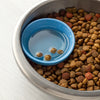What is the Best Dry Dog Food for Skin Allergies?
- Houndsy
Table of Contents
- Introduction
- Understanding Allergies in Dogs
- Choosing the Right Dry Dog Food for Skin Allergies
- Recommended Dry Dog Foods for Skin Allergies
- Additional Tips for Managing Skin Allergies
- Conclusion
Introduction
Imagine waking up in the middle of the night to the sound of your beloved pup scratching incessantly—it's not just annoying; it’s a telltale sign that something isn't right. Skin allergies in dogs can lead to discomfort, irritability, and even long-term health issues if not properly addressed. Research shows that about 10% of dogs suffer from some form of skin allergy, with food allergies being a significant contributor. As responsible pet owners, it’s crucial for us to understand the different types of allergies our dogs may face and how to choose the best dry dog food to alleviate their symptoms.
In this blog post, we will explore the best dry dog food options for dogs suffering from skin allergies. We’ll cover the common allergens, symptoms to watch for, and the nutritional aspects that can help restore your dog's health. By the end of this article, you’ll not only know what to look for in a dog food to combat skin allergies but also how to enhance your dog's overall well-being.
Let’s take a journey together to discover how we can improve our furry friends’ lives through better nutrition, starting with the right dry dog food.
Understanding Allergies in Dogs
Types of Allergies
- Food Allergies: These occur when a dog’s immune system reacts negatively to specific ingredients in their diet. Common culprits include proteins like beef, chicken, lamb, and dairy.
- Environmental Allergies: These are usually triggered by external factors such as pollen, dust mites, molds, and flea bites. Environmental allergies can often manifest as itching and skin irritations.
- Contact Allergies: These occur when a dog comes into direct contact with an allergen, such as certain fabrics, plants, or chemicals.
Symptoms of Allergies
Identifying allergies in our dogs can be challenging, as symptoms may vary widely. Here are some common signs to watch for:
- Persistent scratching or licking
- Red, inflamed skin
- Hot spots or sores
- Hair loss
- Gastrointestinal issues (e.g., vomiting, diarrhea)
- Chronic ear infections
If you notice any of these symptoms, it’s crucial to consult with your veterinarian to determine the underlying cause and appropriate course of action.
The Role of Diet in Managing Allergies
Our dogs’ diets play a pivotal role in the management of allergies. The right dry dog food can help mitigate symptoms and promote overall health. Selecting a product that caters to your dog's specific needs can make a significant difference.
Choosing the Right Dry Dog Food for Skin Allergies
When it comes to selecting the best dry dog food for skin allergies, several factors come into play. Here are some key considerations:
1. Consult Your Veterinarian
Before making any changes to your dog's diet, we recommend consulting with your veterinarian. They can provide valuable insights into your dog's specific allergies and may suggest an elimination diet to identify allergens.
2. Look for Limited Ingredient Diets (LIDs)
Limited ingredient diets are formulated with fewer components, making it easier to identify potential allergens. These diets often feature a single source of protein and carbohydrates, which can help alleviate allergic reactions.
3. Consider Hypoallergenic Options
Hypoallergenic dog foods contain proteins that have been broken down to a size that is less likely to trigger an allergic reaction. These are often used for dogs with more severe food sensitivities.
4. Check for AAFCO Approval
Ensure that the dry dog food meets the nutrient standards set by the Association of American Feed Control Officials (AAFCO). This guarantees that the food provides a balanced diet necessary for your dog’s health.
5. Evaluate Ingredients
Stay away from foods that contain common allergens like corn, soy, and wheat. Instead, opt for whole food ingredients that are easy to digest and rich in nutrients, such as sweet potatoes, peas, and fish.
6. Omega Fatty Acids
Foods rich in omega-3 and omega-6 fatty acids can help improve skin health and reduce inflammation. Look for ingredients like salmon oil or flaxseed oil in your dog’s food.
Recommended Dry Dog Foods for Skin Allergies
Now that we have established what to look for in dog food for skin allergies, let’s explore some of the best options available:
1. Hill’s Prescription Diet z/d
A veterinary-exclusive formula, Hill’s z/d is designed specifically for dogs with food sensitivities. It contains hydrolyzed protein to minimize the risk of an allergic reaction while providing balanced nutrition.
2. Purina Pro Plan Veterinary Diets HA
This hypoallergenic formula is crafted with hydrolyzed proteins and is designed to promote better digestion. It’s especially beneficial for dogs with food allergies and sensitivities.
3. Royal Canin Veterinary Diet Hydrolyzed Protein
Another veterinary-exclusive option, this food uses hydrolyzed soy protein, making it suitable for dogs with meat allergies. It also helps reinforce the skin barrier and promotes healthy skin and coat.
4. Wellness Simple Limited Ingredient Diet
This option features a single source of protein and easily digestible carbohydrates. It's perfect for dogs with food sensitivities and is free from fillers and artificial additives.
5. Natural Balance L.I.D. Potato & Duck Formula
This limited ingredient diet is great for dogs that require a simplified diet. It contains higher levels of omega fatty acids to support healthy skin and coat while minimizing allergic reactions.
Additional Tips for Managing Skin Allergies
In addition to selecting the right dry dog food, we can take several other steps to help our dogs manage their skin allergies effectively:
1. Regular Grooming
Brushing your dog regularly can help reduce allergens that accumulate in their coat. It also stimulates the skin and promotes natural oil production, which can improve skin health.
2. Bathing with Care
Using a gentle, hypoallergenic shampoo can alleviate itching and remove allergens from the skin. Look for products with soothing ingredients like oatmeal or aloe vera.
3. Maintain a Clean Environment
Keep your home clean and free from dust and pollen. Regularly wash your dog’s bedding and vacuum frequently to minimize allergens in their environment.
4. Use Flea Control Products
Fleas can exacerbate skin allergies, so it’s essential to keep your dog on a regular flea prevention regimen.
5. Monitor Treats and Supplements
Be mindful of any treats or supplements you give your dog. Ensure they align with their dietary needs and do not contain potential allergens.
Conclusion
Identifying and managing skin allergies in dogs can be a daunting task, but with the right knowledge and resources, we can provide our furry friends with the comfort and health they deserve. Choosing the best dry dog food for skin allergies is a critical step in this process. By consulting with our veterinarians and selecting high-quality, hypoallergenic, or limited ingredient diets, we can help alleviate our dogs’ discomfort and improve their quality of life.
If you’re looking for a convenient way to enhance your dog’s feeding experience, consider the Houndsy Kibble Dispenser. This innovative product not only ensures perfect portion control but also complements your home decor with its stylish design. Explore more about how the Houndsy Kibble Dispenser can simplify your dog feeding routine by visiting Houndsy Kibble Dispenser.
FAQ
What are the most common food allergens for dogs?
Common food allergens in dogs include beef, chicken, dairy, wheat, and soy.
How can I tell if my dog has a food allergy?
Signs of food allergies in dogs include persistent itching, gastrointestinal issues, ear infections, and skin irritations.
Should I consult my veterinarian before changing my dog's diet?
Yes, it is crucial to consult your veterinarian, especially if your dog shows signs of allergies.
What is a limited ingredient diet?
A limited ingredient diet features fewer ingredients, making it easier to identify allergens and is often easier for dogs with sensitivities to digest.
Can environmental factors contribute to my dog's skin allergies?
Absolutely. Environmental allergens like pollen, dust, and fleas can significantly affect your dog's skin health and lead to allergies.
By taking the necessary steps and investing time in our dogs' nutrition, we can ensure they live happy, healthy lives. Let’s commit to making informed choices for our furry companions!












